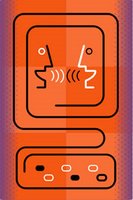 The following is a guest post by Ruben Lopez, school psychologist with the Moreno Valley Unified School District, CA and member of the IQs Corner Virtual Community of Scholars. Rueben reviewed the following article and has provided his comments below. Welcome aboard Ruben.
The following is a guest post by Ruben Lopez, school psychologist with the Moreno Valley Unified School District, CA and member of the IQs Corner Virtual Community of Scholars. Rueben reviewed the following article and has provided his comments below. Welcome aboard Ruben.Bishop, D. V. M. (2006). What causes specific language impairment in children? Current Directions In Psychological Science, 15, 217-221. (click here to view)
Abstract
- Specific language impairment (SLI) is diagnosed when a child’s language development is deficient for no obvious reason. For many years, there was a tendency to assume that SLI was caused by factors such as poor parenting, subtle brain damage around the time of birth, or transient hearing loss. Subsequently it became clear that these factors were far less important than genes in determining risk for SLI. A quest to find “the gene for SLI” was undertaken, but it soon became apparent that no single cause could account for all cases. Furthermore, although fascinating cases of SLI caused by a single mutation have been discovered, in most children the disorder has a more complex basis, with several genetic and environmental risk factors interacting. The clearest evidence for genetic effects has come from studies that diagnosed SLI using theoretically motivated measures of underlying cognitive deficits rather than conventional clinical criteria.
- Clearly and concisely, Bishop explains how genetics and cognitive assessment may help to identify and intervene early in specific language impairment (SLI)-“a heterogenous category, varying in both severity and profile of disorder, but in most cases it is possible to demonstrate problems with both understanding and producing spoken language….”
- Regarding the genetics of SLI, although twin studies have yielded significant heritability estimates, ranging from .5 to .75, Bishop reports that in most families SLI is not “inherited in a simple fashion”, rather SLI “resembles complex genetic disorders, such as asthma and diabetes…” And in a rare family where 50% of the children had an affected parent and a specific chromosomal mutation has been found, the defective gene was not the hoped for gene for language, but rather appeared to regulate the activity of other genes, some affecting “many brain systems important for speech and language…” So a simplistic genetic model of SLI has shown to be inaccurate.
- Similarly, Bishop has found a simplistic diagnostic definition of SLI to be inaccurate. Using twin (genotype) studies to define a SLI phenotype (observed characteristics), she found “simply categorizing children as affected or unaffected on the basis of conventional language tests was not an effective approach to phenotype definition.” She, therefore, decided to look for “endophenotypes, measures of underlying factors thought to play a causal role in the disorder.” She defines this approach as “doing genetic analysis using experimental measures that were derived from particular theoretical accounts of SLI.”
- In her search for endophenotypes of SLI, Bishop found that “impaired nonword repetition” showed evidence of a “strong genetic influence.” Her theoretical explanation for selecting the nonword repetition task is that SLI is suspected of being caused by an “impairment in a system that is specialized for holding verbal material in memory for short periods of time-phonological short-term memory (STM).” She described the task as “asking children to repeat meaningless sequences of syllables, such as “perplisteronk” or “blonterstaping.”
- Yet testing the notion that SLI “can be traced to a more general deficit affecting perception of auditory input”(perhaps in CHC terms attributing SLI to broad Ga rather than to narrow Ga processes) Bishop found that “a measure of nonverbal auditory perception (identification of tone sequences) did not prove to have a significant genetic influence. She added that she found that “the effect of shared environment on the tone-sequence task accounted for about 60% of the variance, but almost half of this effect could be accounted for by a measure of the amount of live music experienced at home.”
- Also, she found a measure of children’s ability to add appropriate inflectional endings to verbs (grammar)-a measure which Bishop described as another measure of phonological STM, a description which does not fit John Carroll’s placement of a narrow Grammatical Sensitivity factor under Gc. Based on her endophenotype approach-combining genetics with psychometrics--Bishop described a dual deficit model of SLI, consisting of a deficit in both nonword repetition and grammatic sensitivity. Regarding the unique contribution of each measure to an endophenotype of SLI, Bishop wrote, “Both impairments were found in SLI, and both were heritable, yet they were only weakly correlated, and the genetic analysis suggested that different genes were implicated in the two deficits.”
- Based on the two-deficit model of SLI, Bishop concluded that “…it seems as though a child has to be impaired in more than one domain in order for language to be seriously impaired”, leading to the optimistic hypothesis that “Language is unusually surprisingly robust in the face of adverse developmental circumstances. This suggests that there may be multiple routes to effective language acquisition, and if one route is blocked, another can usually be found.”
- Regarding intervention, Bishop speculates that “multiple routes to effective language acquisition” mean that “…there is every reason to suppose that ways of modifying the course of the disorder may be discovered, especially if new genetic knowledge is used to identify children at risk early so that intervention can begin at a young age.”
- One question I have regarding Bishop’s psychometric findings is whether they indicate that we should be careful in only considering or overemphasizing the Broad CHC factors in understanding and addressing categories of disability, such as specific language impairment?
powered by performancing firefox

No comments:
Post a Comment
Note: Only a member of this blog may post a comment.